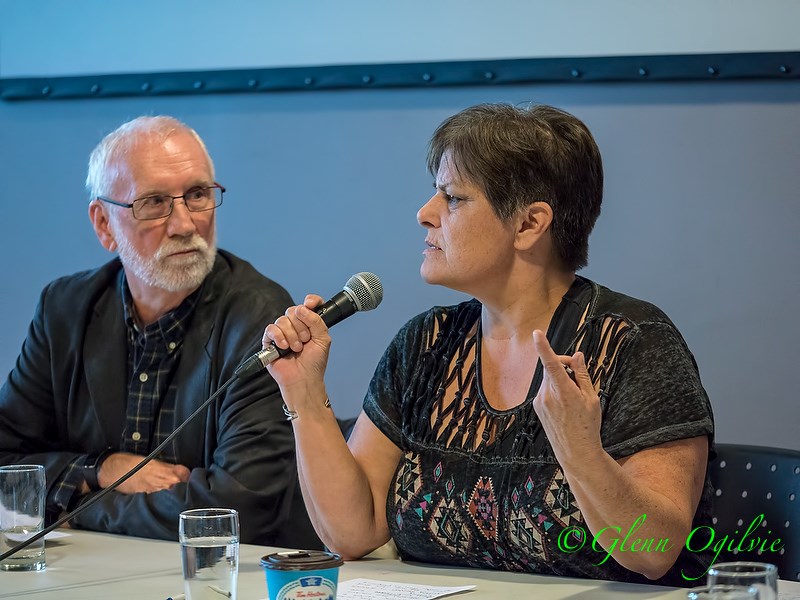Cathy Dobson
The environmental record of local industry took a beating before a group of U.S. journalists gathered at the Aamjiwnaang First Nation last week.
A panel of environmental heavyweights including Elaine MacDonald of Ecojustice, Ontario Environmental Commissioner Dianne Saxe, and health researcher Jim Brophy called for tougher emission regulations and enforcement.
While there has been ongoing improvement in the Chemical Valley the “cumulative effect of all this toxic air pollution is egregious,” said Brophy, founder of Sarnia’s occupation health clinic.
Over the past decade, emission limits for benzene and sulphur dioxide have been reduced but they are still far above the limits in the U.S., said Saxe.
“There are about 57 sources of pollutants and contaminants near Aamjiwnaang and it’s regulated like there was only one contaminant,” she said.
The cumulative health effects of exposure to numerous toxins over an extended period of years needs to be studied, Saxe said.
Brophy said Ontario’s regulatory system is broken because it’s “disproportionately in tune with industry” at the expense of public health.
The Ontario government introduced stricter pollution standards in 2016 but many multinational corporations applied for and received exemptions, pleading that the cost to upgrade facilities to meet the standards was prohibitive.
“Sarnia still represents some of the highest toxic exposures in Ontario,” said Brophy. The residents of Aamjiwnaang who live surrounded by petrochemical plants are subjected to “environmental racism,” he charged.
“Unfortunately, for Sarnia, it’s not that the community doesn’t care,” Brophy added. “But they are always facing the economic blackmail of job loss.”
He called the tradeoff of good health for good jobs a crisis in blue-collar communities across North America.
Ada Lockridge, an Aamjiwnaang resident, has spent years demanding accountability from the companies that border her community.
High rates of asthma, cancers, reproductive problems, rashes and headaches cannot go unanswered, Lockridge said.
“We’re here and we matter.”
Elaine MacDonald was part of an Ecojustice team that sued the Ontario government twice on behalf of Aamjiwnaang for failing to regulate the cumulative effects of air pollution in Chemical Valley.
U.S. refineries are far more regulated than Canadian ones, she said.
“Fourteen of 15 refineries in Canada emit more air pollution than comparable refineries in the U.S. emit – as much as 50 to 60 times more – and some of the worst offenders can be found in Chemical Valley,” MacDonald said.
The panel was assembled by the Society of Environmental Journalists, which brought 15 journalists and students from as far away as California and Illinois to tour the Chemical Valley on Oct. 4.
An organizer said local industry reps were invited but declined to participate.
But Sarnia-Lambton MP Marilyn Gladu took part and spent much of her time defending industry’s record.
There’s been a 70% sulfur dioxide reduction in the last decade and new benzene guidelines are 20 times more stringent than in California, she said.
“Companies in the Valley do a very good job of complying with regulations as they are introduced,” said Gladu, although she admitted exceedances are still allowed, although they’ve been dramatically reduced.
“They are still not zero so obviously there is more work to be done,” she said.
“The challenge for government is to catch up with the U.S.”
Gladu agreed with several panelists who called for a comprehensive health study on the cumulative effects of Chemical Valley emissions and said the federal government is supportive.
Local residents and the Sarnia Lambton Environmental Association have talked for decades about a health study but the process stalled.
Calls made by The Journal to the Sarnia Lambton Environmental Association, which represents 20 local industries, were not returned by press time.
